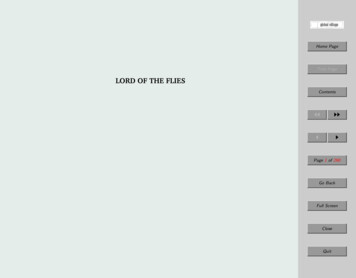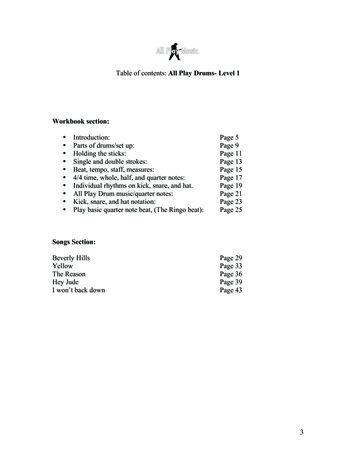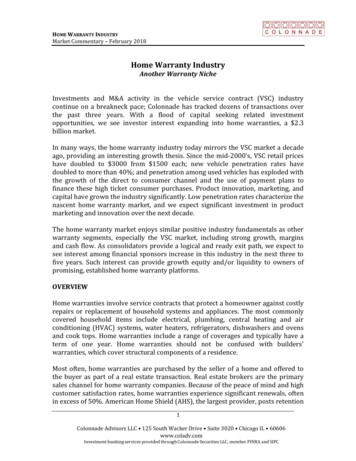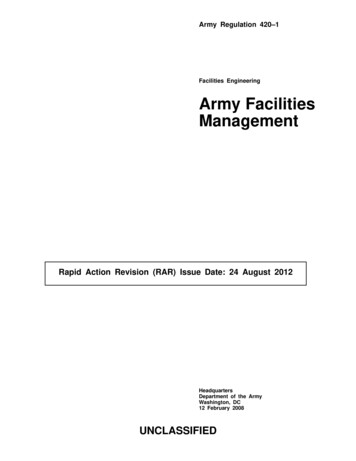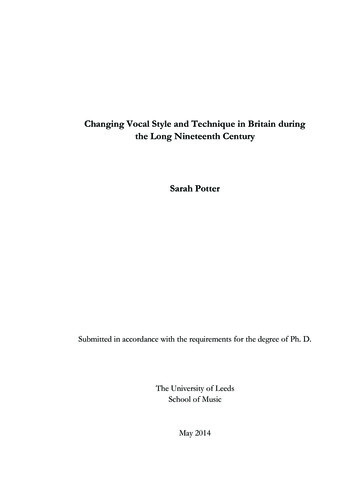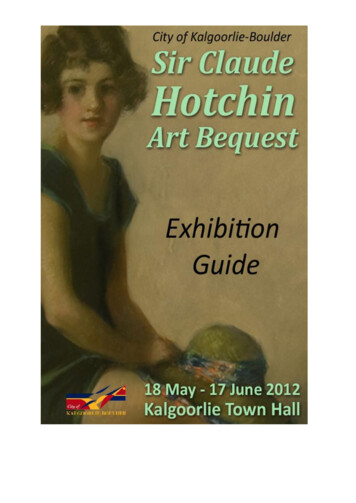
Transcription
IntroductionIn 1955 the Municipality of Kalgoorlie was given a gift of 32 works of art byClaude Hotchin, with another 2 works donated the following year. ClaudeHotchin was a business man from South Australia who owned successfulhardware shops in Perth. He had a passion for art and after retiring from hisbusiness acquired a large collection of works which he displayed in his owngallery.An annual competition called the Claude Hotchin Art Prize was started in thelate 1940’s; a 50 prize was awarded to the best oil and the best watercolour byan artist who had lived in Western Australia for no less than two years.Hotchin’s philanthropic nature saw him donate portions of his collection to localMunicipalities to form public art galleries and Kalgoorlie was the eighth localgovernment body to receive such a gift. At the time of the first opening of thepublic art gallery, the works were hung in the Kalgoorlie Town Hall at the foot ofthe staircase and in the foyer and remained there for a number of years, to givethe gallery added illumination the lighting in the town hall was replaced withnew fluorescent bulbs.The Claude Hotchin Bequest is a collection of artworks that at the timecomprised a mixture of up and coming artists who became famous and a fewwho already had a reputation for fine work. In the Kalgoorlie collection are oils,watercolours and an etching, all excellent examples of the artist’s skills.The History and Heritage Unit of the City of Kalgoorlie Boulder would like towelcome you to examine these fine works and explore the art and the artistswho created the works.
George Feather Lawrence(b. Annandale NSW, 14/06/1901; d. 1981)Australian born George Lawrence studied at the Sydney Art School and workedas an advertising artist. He exhibited his urban landscapes and street scenes(such as this work) around the country and often at the Macquarie Gallery in hishome town of Sydney. Lawrence’s use of harmonious colour in this rain sweptSydney street is an example of impressionism, his interplay of light and colourand the blurring of distinction between people and objects is also typical of thestyle. The use of these elements won Lawrence much appreciation from hiscontemporaries and art critics from the 1950’s saw an affinity with such famousartists as Camille Pissarro and at times Maurice Utrillo. Lawrence’s works hangin all major Australian Galleries.--- ---No. 1“Bridge Street, Sydney”(BY GEORGE F. LAWRENCE)George Lawrence was trained at the Sydney Art School and for years wasoccupied with Commercial Art, an occupation in which many well- knownand famous artists began their artistic careers, this artist’s work hasarrived at the place where it has a rather more factual romanticexpression in which Streetscapes play a considerable part. His picturesare harmonious in colour, his pigment describes excellently a variety oftextures and he has a special regard for essential pictorial factors. Mr.Lawrence’s work follows closely the Art of Impressionism and his workhas an air of detachment and contemplativeness which calls to mind thatgreat artist Maurice Utrillo. George Lawrence has received gratifyingrecognition for his art over a number of years, and a number of hispictures have been bought by the Sydney Art Gallery, as well as otherimportant Australian Art Galleries.From the original 1955 catalogueWritten by Claude Hotchin 1955
Bridge Street, SydneyGeorge Lawrence1954Oil on Board77.0 x 90.0 cm
Douglas Roberts Dundas MBE(b. Inverell, NSW 25/01/1900; d. 30/06/1981 NSW)Douglas Dundas is one of Australia’s most distinguished artists of the 20thcentury, and his work is known far beyond these shores. Born in New SouthWales, he attended the Sydney Art School, working during the day as a windowdresser in retail stores and attending night classes and weekend paintingclasses. His work is known for its modernistic style especially his other works inurban landscapes. "Lucerne Flats" was exhibited in Perth at Claude HotchinGallery in 1948 and is noted for Dundas’s blonde style of art, its rich cleartreatment of light and harmony of pattern and colour. The artwork itself wasframed at “S. A. Parker Pty Ltd”, Sydney. The company was run by the father ofDudley Parker, who is also represented in this collection.Dundas was a full time staff member of the art School at Sydney TechnicalCollege. He was made head teacher of painting 1938 – 1960, then head ofschool until 1965. He won the NSW Society of Travelling Artists Scholarship in1927 and the Wynne Prize in 1943, was one of the Trustees of the NSW ArtGallery 1948 – 1969 and President of NSW Society of Artists from 1948.Dundas received an MBE (Member of the British Empire) in 1969 for his servicesto art.--- ---No. 2“Lucerne Flats”(BY DOUGLAS DUNDAS)Douglas Dundas is a well-known Australian artist in Landscape and figurepainting whose work shows a sensitive appreciation of nature’s subtleties.It is quiet work, by a man who scorns pyrotechnical displays and it is workwhich will always find a place because of its attractive and personalrealisation of the nuance. Douglas Dundas is above all else an inquiringpainter. In addition to his painting, he is a draughtsman with a sensitivetechnique. His drawings are thoroughly worked out and are notable for atrue drawing quality. Mr. Dundas has done well with his art. In 1927 hewon the Sydney Society of Artist’ Travelling Scholarship with which hestudied in England and Europe for two years, he exhibited at the RoyalAcademy and Paris Salon in 1929. He was appointed a teacher of LifeDrawing at the East Sydney Technical College in 1930 and later becameHead Painting Teacher at that important School of art. Douglas Dundashas his work hanging in all the big Art Galleries of Australia.Taken from the original 1955 catalogueWritten by Claude Hotchin
Lucerne FlatsDouglas Dundas1947Oil on Canvas55 x 65cm
Dudley Bruce Parker(b. Killara, NSW 17/07/1914; d. Unknown)Born in New South Wales, Dudley Parker had a long interest in art, starting as aPicture Framer for his family’s business “S.A. Parker” in George Street, Sydney.After a brief stint in the Army during the Second World War, Parker startedpainting, being self taught and coached by other artists like Arthur Streeton,Frederick McCubbin and Norman Lindsay. These artists used the services ofParker’s father and himself to frame many of their works which hang in majorgalleries around the world. Critics from the 1950’s saw Parker's work as a crudestyle of modern painting, a style that started in the 1890’s with Cezanne andGauguin and continued on to the minimalists of the 1960s and 1970s.--- ---No. 3“Morning in the Valley”(BY DUDLEY PARKER)Dudley Parker is a man of outstanding ability in his art, he early in life,was fortunate to be to have amongst his contacts, which he was able tomake through his father’s business in Sydney (which was a well-knownpicture framing business) such famous Australian artists as the late SirArthur Streeton, Elioth Gruner, Fred McCubbin and Hilder. These greatmen noted this young man’s desire to become an artist and often lookedat his work and advised him from time to time, then of course he hasenjoyed the friendship of such noted living artists as Norman Lindsay,Robert Johnson, John Eldershaw and so on, so that it is little wonder thatDudley Parker is gradually finding his way to the top in the art worldamongst the artists around his own age. His work is sought after verymuch and thought highly of. Dudley Parker has his work hanging inseveral Art Galleries in Eastern Australia, and in several of the CountryGalleries of Western Australia.Taken from the 1955 catalogueWritten by Claude Hotchin
Morning in the ValleyDudley ParkerDate unknownOil on Board60 x 70cm
Maxwell Christopher Richard Ragless(b. Edwardstown, SA. 10/08/1901. d 04/01/1981 Adelaide, SA.)Max Ragless attended Kyre College (Scotch College), Adelaide where he receivedformal artistic training. After he left school Ragless was a wool classer andworked in vineyards while pursuing an artistic career. During the Second WorldWar Ragless worked with the department of Home Security as a camouflageofficer and in March 1945 he was appointed one of seven war time artists, hewas to record the mobilisation of primary and civil industries related to war timeproduction.Strongly influenced by Hans Heysen and Tom Roberts, Ragless’s work can bedescribed as romantic; it is also a bold work with dry harmonious colours.--- ---No. 4“Albury Landscape”(BY MAX RAGLESS)Max Ragless is in the forefront of the younger Australian artists to-day, hisbrilliant and vigorous work has won him many laurels. Mr. Ragless ispractically self taught, to-day he has many admirers of his fine work,which ranks high in Australian art to-day. Mr. Ragless for many yearsearned his living as a vigneron in the Adelaide Foothills, but now he givesall his time to his art. Mr. Ragless has his work hanging in most of theimportant art Galleries in Australia and much has gone overseas. Thisartist is looked upon as an artist of great promise and is definitely a leaderin his age group in Australian art to-day.Taken from the 1955 catalogueWritten by Claude Hotchin
Albury LandscapeMax RaglessDate unknownOil on Canvas67 X 67cm
Janet Agnes Cumbrae Stewart(b. Brighton, Vic 23/12/1883; d. South Yarra Vic 08/09/1960)Janet Cumbrae Stewart (she dropped the hyphen later in her career) was one offew notable women artists in early 20th century Australia and is mainly knownfor her work with female nudes in pastels, which many critics noted werecompleted in a non vulgar style. Cumbrae Stewart studied art at the NationalGallery School and was awarded a number of prizes for her work during her timethere. She travelled and lived in Europe with her companion Miss ArgemoreFarrington Bellairs, who was her publicist and business manager. CumbraeStewart had great success in Europe, North America and Australia, where herskills as an artist were highly sought after. This artwork is a brilliant example ofCumbrae Stewart's talent with pastels.--- ---No. 5“The Young Bather”(BY JANET AGNES CUMBRAE-STEWART)Miss Cumbrae-Stewart was born in Melbourne and studied at theMelbourne National Gallery, she won second prize in connection with theTravelling Scholarship competition given in Melbourne in the year 1908,she went to London and lived there some years, Miss Stewart exhibitedher work at the Royal Academy, the Venice International Exhibition, RoyalGlasgow Institute and the Old Salon, where she was awarded thehonourable mention in 1923. Miss Cumbrae-Stewart has work hanging inthe Sydney, Melbourne, Adelaide and Brisbane Art Galleries, she didquite a lot of her work in pastels at which she excelled, this picture “TheYoung Bather” is a pastel work.Taken from the 1955 catalogueWritten by Claude Hotchin
Young BatherJanet Cumbrae StewartDate unknownPastel on paper70.0 x 60.0 cm
John Roy Eldershaw(b. Randwick NSW 1892; d. Nimmitabel, NSW 20/05/1973)Born in New South Wales, John Eldershaw studied art under the instruction ofJulian Ashton in Sydney and at the Central School of Art, London. He paintedmainly landscapes in watercolour, which were exhibited at the Royal AcademyLondon and in Paris. A prolific painter, he had over 50 exhibitions of his workaround the world. Eldershaw was a member of the NSW Society of Artists, theAustralian Art Association and the Australian Watercolour Institute of which hewas President 1945 – 1951. He was a wartime artist and was a camouflageofficer in the RAAF in Victoria. Eldershaw was commissioned by the Duke ofGloucester while the Duke was Governor General to paint a number of“Australian landscapes”. His work is described as fresh, broad and vigorous, butvaried according to subject, mood and desired effect.In 1948 when “Brandy Mary Flat” was exhibited it was named the finest work inthe exhibition by the art critics.--- ---No. 6“Brandy Mary Flat”(BY JOHN ELDERSHAW)John Roy Eldershaw was born at Sydney in 1892. He had the goodfortune to early come under the guiding hand of that famous oldAustralian Art Master Julian Ashton, he also studied under J. S. Watkins,and again at the Central School of Art, London. Mr. Eldershaw exhibitedhis work at the Royal Academy and at the Old Salon in 1927. He is amember of the Sydney Society of Artists, Australian Art Association andAustralian Water Colour Institute. Mr. Eldershaw’s work is well known,and much sort after, his pictures have been purchased by all theimportant Art Galleries in Australia and many of his paintings have goneoverseas. His work is sound in all aspects.Taken from the 1955 catalogueWritten by Claude Hotchin
Brandy Mary FlatJohn Eldershawc. 1948Watercolour on paper60.0 x 70.0 cm
George Whinnen(b Gawler, SA 1891. d. Adelaide, SA 1950)George Whinnen was a well known South Australian artist, who worked in avariety of media. He was well known principally for his watercolours oflandscapes, still-life and etchings. He was president of the Royal SouthAustralian Society of arts from 1940 - 1949 and won several awards.He is represented in the art Gallery of South Australia and the Broken Hill ArtGallery. This work of Whinnen's, a study of flowers, is rich in colour with strongcontrasts, a fine example of his work on this subject.--- ---No. 7“Spring Flowers”(BY GEORGE WHINNEN)George Whinnen lived mostly in South Australia, where he became thePresident of the Adelaide Art Society, unfortunately he died of a heartattack when only about 56 years of age, at a time when he was beginningto reap the harvest that was due to him for his excellent contributions toAustralian art, his work was highly appreciated throughout the land, hepainted both in oils and Water colour, he was equally at home whenpainting landscape, seascape, flower pieces or portraiture. His work maybe found in a number of Art Galleries throughout Australia, and in manyimportant private collections.Taken from the 1955 catalogueWritt
picture framing business) such famous Australian artists as the late Sir Arthur Streeton, Elioth Gruner, Fred McCubbin and Hilder. These great men noted this young man’s desire to become an artist and often looked at his work and advised him from time to time, then of course he has enjoyed the friendship of such noted living artists as Norman Lindsay, Robert Johnson, John Eldershaw and so on .




